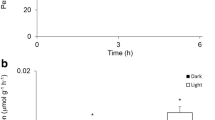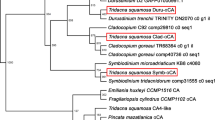Abstract
The giant clam Tridacna crocea harbors in the mantle tissue symbiotic microalgae commonly called zooxanthellae. Isolated zooxanthellae release glycerol into the medium in the presence of mantle tissue homogenate (MH), but it is not clear whether the cells do so in situ. In order to determine the photosynthetic products released by zooxanthellae in the mantle of the giant clam we traced photosynthetic fixation products from 13C- and 14C-bicarbonate both in the clam and in isolated zooxanthellae (IZ) in the presence or absence of MH. After 15 min incubation in the absence of MH the IZ released less than 0.6% of the fixed labeled carbon, mainly as glucose. The major intracellular photosynthates were neutral lipids, which constituted 20 to 40% of the total extractable 14C. In the presence of MH, the IZ released up to 5.6% of the total fixed 14C, mostly as glycerol, and the major intracellular photosynthate was glucose. In an intact clam incubated in sea water containing 14C-bicarbonate, 46 to 80% of the fixed 14C was translocated from the zooxanthellae to the host tissues. Most of the 14C in the hemolymph, in the isolated zooxanthellae and in intact mantle tissue (containing zooxanthellae) was recovered as glucose. No 14C-glycerol was detected in the mantle after 1 to 30 min incubation, and, even after 60 min, far less 14C-glycerol was synthesized than by IZ in the presence of MH. The possibility that in clam tissue glycerol is converted to glucose was examined by tracing the labeled carbon from 14C-glycerol injected into the adductor muscle. After 5 min incubation, no labeled glucose was found in the hemolymph, but after 60 min, some 20% was found as glucose. Thin slices containing zooxanthellae, cut from the surface of the mantle, fixed inorganic carbon supplied as NaH14CO3 in the medium and mainly released 14C-glucose. The addition of MH to the surrounding medium did not affect the release rate or form of release product. When the slices were cut into smaller pieces, however, the ratio of glycerol to glucose in the release product increased. These results indicate that in the presence of MH the metabolism of isolated zooxan- thellae was different from that of zooxanthellae in the mantle. In the presence of MH, isolated zooxanthellae release mostly glycerol, whereas in the mantle they release glucose.
Similar content being viewed by others
Author information
Authors and Affiliations
Additional information
Received: 18 February 1998 / Accepted: 4 December 1998
Rights and permissions
About this article
Cite this article
Ishikura, M., Adachi, K. & Maruyama, T. Zooxanthellae release glucose in the tissue of a giant clam, Tridacna crocea. Marine Biology 133, 665–673 (1999). https://doi.org/10.1007/s002270050507
Issue Date:
DOI: https://doi.org/10.1007/s002270050507




